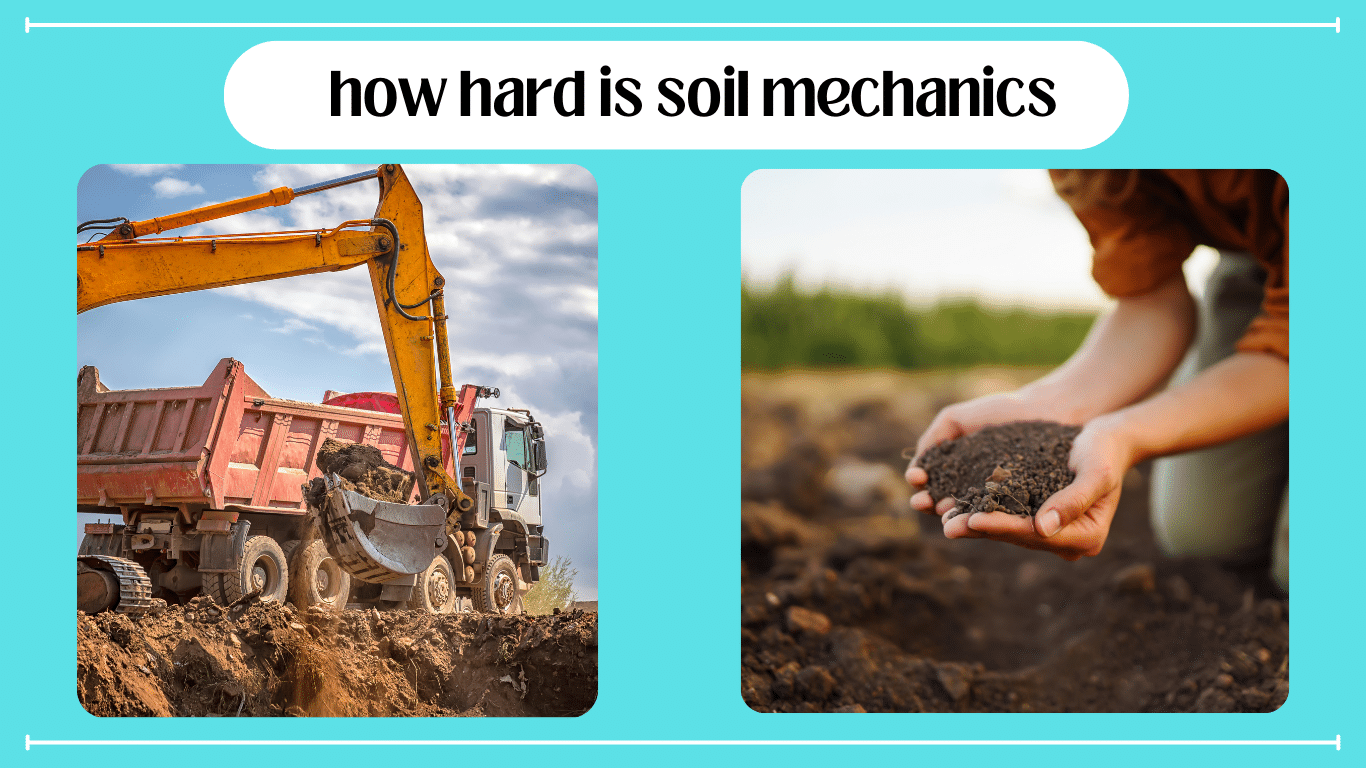Understanding soil mechanics can be quite challenging for many people, and the question of how hard is soil mechanics comes to mind. It involves studying how soil behaves under different conditions, like when buildings are constructed on it or when roads are built through it. Soil mechanics requires knowledge of various concepts from geology, physics, and engineering.
It’s like figuring out how a puzzle piece fits into a larger picture. Sometimes, the properties of soil can be unpredictable, making it even more challenging. However, with patience and practice, anyone can grasp the basics of soil mechanics and appreciate its importance in various construction projects.
Understanding Soil Mechanics: Exploring Its Complexity
Soil mechanics might sound like a complicated term, but in simple words, it’s all about understanding how soil behaves under different conditions. Just like how buildings need strong foundations, understanding soil mechanics helps engineers and builders create sturdy structures that can withstand the test of time. Let’s delve into the basics of soil mechanics to demystify its complexities.
What are soil mechanics & How hard is soil mechanics
Soil mechanics is a branch of civil engineering that deals with the study of soil properties, behavior, and its interaction with structures. It helps engineers understand how soil responds to different forces like weight, water, and pressure.
Why is it important?
Soil mechanics is crucial because it forms the basis of many construction projects. Whether it’s building skyscrapers, roads, bridges, or dams, understanding soil mechanics ensures that structures are safe and stable. Without this knowledge, buildings could collapse, roads could crack, and dams could fail.
Factors Affecting Soil Behavior
- Composition
- Water Content
- Pressure
- Load Distribution
Composition: Soil is made up of various materials like sand, clay, silt, and organic matter. The composition affects its strength, density, and permeability.
Water Content: The amount of water in the soil significantly influences its behavior. Too much water can make it weak and unstable, while too little water can cause it to shrink and crack.
Pressure: The weight of structures and objects resting on the soil exerts pressure. Soil mechanics helps engineers calculate this pressure to ensure that it doesn’t exceed the soil’s bearing capacity.
Load Distribution: Understanding how the soil distributes the load is crucial for designing foundations. Different types of soil have different load-bearing capacities, which must be taken into account during construction.
Challenges in Soil Mechanics
- Heterogeneity
- Anisotropy
- Time Dependency
Heterogeneity: Soil properties can vary widely, even within a small area. This heterogeneity makes predicting soil behavior challenging.
Anisotropy: Soil can behave differently depending on the direction of the applied force. This phenomenon, known as anisotropy, adds another layer of complexity to soil mechanics.
Time Dependency: Soil behavior can change over time due to factors like weathering, erosion, and consolidation. Predicting long-term soil stability requires accounting for these time-dependent processes.
there are some important key points we will try to understand
Understanding Soil Behavior: Soil mechanics helps us understand how soil behaves when structures are built on it.
Safety First: Engineers must study soil mechanics to ensure buildings, roads, and other structures are safe and won’t collapse.
Soil Composition Matters: Different types of soil, like sand, clay, and silt, have different properties that affect how strong they are.
Water’s Role: Too much or too little water in the soil can make it unstable, so engineers need to consider water content when designing structures.
Pressure Check: Soil mechanics helps engineers calculate how much pressure the soil can handle from buildings and other heavy objects.
Even Load Distribution: Engineers need to understand how soil spreads out the weight of structures to design stable foundations.
Challenges Abound: Soil can be tricky because it varies a lot even in small areas, making it hard to predict its behavior.
Different Directions, Different Behaviors: Soil might act differently depending on which way the force is applied, adding complexity to the study.
Changes Over Time: Soil doesn’t stay the same forever; it can change due to weathering, erosion, and other factors, which engineers must consider.
Building Safely: Thanks to soil mechanics, engineers can design structures like skyscrapers and bridges that can withstand the test of time and keep us safe.
there are many questions on the internet that people are trying to find answers to, so here I am going to discuss some of them
How to Study Soil Mechanics
Studying soil mechanics involves learning about the behavior of soil under different conditions. You can start by understanding the basics of soil composition, types of soil, and how water affects soil stability. Books, online resources, and courses offered by universities are great places to begin. Additionally, hands-on experience through fieldwork and laboratory experiments can deepen your understanding of soil mechanics.
Scope of Soil Mechanics
The scope of soil mechanics is vast, as it encompasses various aspects of soil behavior and its interaction with structures. Engineers use soil mechanics principles to design foundations for buildings, roads, bridges, and other infrastructure projects. It also extends to geotechnical engineering, environmental engineering, and even agricultural practices where soil stability and fertility are essential considerations.
Importance for Civil Engineers
Civil engineers must study soil mechanics because it forms the foundation of their work. Understanding soil behavior is crucial for designing safe and stable structures. Without proper knowledge of soil mechanics, engineers risk building structures that may fail or become unsafe over time. Soil mechanics also helps engineers assess the risks associated with construction projects and implement appropriate mitigation measures.
Difference Between Soil Mechanics and Soil Engineering
While soil mechanics focuses on understanding the physical and mechanical properties of soil, soil engineering applies this knowledge to practical applications in construction and geotechnical projects. Soil mechanics deals with theories and principles, whereas soil engineering involves the practical implementation of those theories to solve real-world problems.
Future Scope of Soil Science
The future of soil science is promising as it plays a vital role in addressing global challenges such as food security, environmental sustainability, and climate change. Advances in soil science will enable us to develop more efficient agricultural practices, mitigate soil erosion, and manage land resources effectively. Additionally, soil science will continue to contribute to infrastructure development and environmental conservation efforts worldwide.
Field Tests for Soil Mechanics
Field tests are essential for assessing soil properties in real-world conditions. Common field tests include standard penetration tests (SPT), cone penetration tests (CPT), and plate load tests. These tests provide valuable data on soil strength, density, and bearing capacity, which are crucial for designing foundations and evaluating site suitability for construction projects.
Who Studies Soil Science?
Various professionals study soil science, including soil scientists, geologists, agronomists, environmental scientists, and civil engineers. These individuals work in diverse fields such as agriculture, construction, environmental management, and research institutions, contributing to our understanding and sustainable management of soil resources.
Study of Soil Mechanics
The study of soil mechanics is called geotechnical engineering, or geotechnics. Geotechnical engineers apply principles of soil mechanics to analyze soil behavior and design foundations, retaining structures, and earthworks. They play a critical role in ensuring the safety and stability of infrastructure projects by assessing soil properties and recommending appropriate engineering
Conclusion
While soil mechanics may seem daunting at first, it’s a fascinating field that plays a vital role in construction and engineering. By understanding how soil behaves and reacts to external forces, engineers can design safer and more durable structures. So, the next time you see a towering skyscraper or drive over a sturdy bridge, remember that it’s all thanks to the principles of soil mechanics that ensure the ground beneath is solid and stable.
FAQs
What is soil mechanics? Soil mechanics is the study of soil behavior under various conditions, particularly concerning its interaction with structures.
Why is soil mechanics important for civil engineers?
Civil engineers need to understand soil mechanics to design safe and stable structures, ensuring they withstand environmental forces and last over time.
What’s the difference between soil mechanics and soil engineering?
Soil mechanics deals with understanding soil properties, while soil engineering applies this knowledge to practical construction projects.
What career paths involve studying soil science?
Careers in soil science include soil scientists, geologists, agronomists, environmental scientists, and civil engineers, working in fields like agriculture, construction, and environmental management.
What are some common field tests for soil mechanics?
Common field tests include standard penetration tests (SPT), cone penetration tests (CPT), and plate load tests, which provide data on soil strength and density.
How can I study soil mechanics?
You can learn soil mechanics through books, online resources, university courses, and hands-on experience in fieldwork and laboratory experiments.
What’s the scope of soil mechanics?
Soil mechanics has a broad scope, ranging from designing foundations for buildings to assessing soil stability for infrastructure projects and environmental conservation efforts.
What’s the future outlook for soil science?
The future of soil science is promising, with potential applications in improving agricultural practices, managing land resources sustainably, and addressing global challenges like climate change and food security.
Who uses soil mechanics principles in their work?
Professionals such as civil engineers, environmental scientists, geotechnical engineers, and agricultural researchers utilize soil mechanics principles in their respective fields.
Why is understanding soil behavior important beyond construction?
Soil behavior impacts various sectors, including agriculture, environmental conservation, and infrastructure development, making it crucial for addressing global challenges and ensuring sustainable development.




